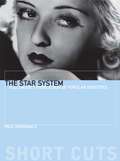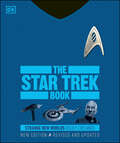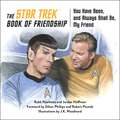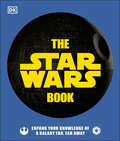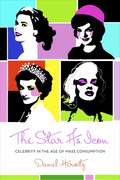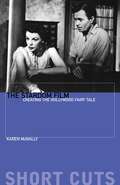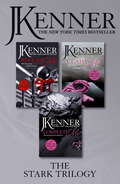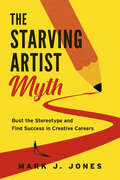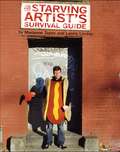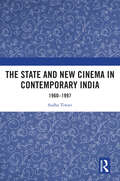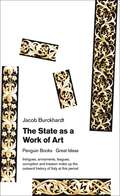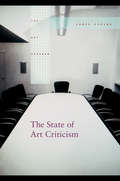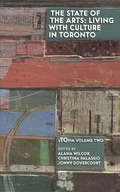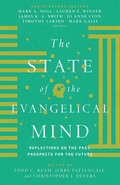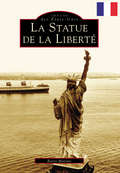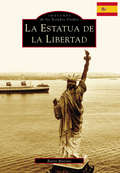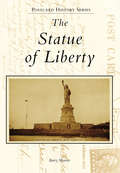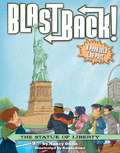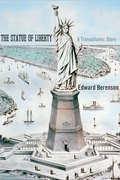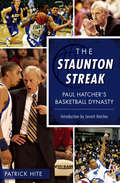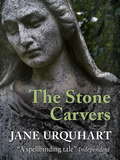- Table View
- List View
The Star System: Hollywood's Production of Popular Identities (Short Cuts)
by Paul McDonaldLooks at the development and changing organization of the star system in the American film industry. Tracing the popularity of star performers from the early "cinema of attractions" to the Internet universe, Paul McDonald explores the ways in which Hollywood has made and sold its stars. Through focusing on particular historical periods, case studies of Mary Pickford, Bette Davis, James Cagney, Julia Roberts, Tom Cruise, and Will Smith illustrate the key conditions influencing the star system in silent cinema, the studio era and the New Hollywood.
The Star Trek Book New Edition
by Paul J. RuditisTo boldly expand your Star Trek horizons. Re-engage! The new edition of The Star Trek Book takes readers even further into one of the greatest science fiction universes ever created. This unique, insightful, and comprehensive examination of an enduring, much loved franchise features every era of Star Trek in one volume, from the pioneering 1960s TV series to the latest movies and streaming shows, including Star Trek: Beyond, Star Trek: Discovery, Star Trek: Picard, and Star Trek: Short Trek.Written by Star Trek experts, this book is packed with stunning film and TV stills, illuminating infographics, and incisive, specially curated essays that unlock the mysteries of the ever-expanding Star Trek Universe. From new and legendary heroes such as James T. Kirk, Jean-Luc Picard, and Michael Burnham to iconic villains like Khan, Q, and the Borg, to fascinating alien species like the Vulcans, Klingons, and Ferengi, this book explores the central characters, technology, civilizations, and events that have shaped the complex, epic story of Star Trek.Resistance is futile. This is the (star) trek of a lifetime you don't want to miss! TM & © 2020 CBS Studios Inc. © 2020 Paramount Pictures Corp. STAR TREK and related marks and logos are trademarks of CBS Studios Inc. All Rights Reserved.
The Star Trek Book of Friendship: You Have Been, and Always Shall Be, My Friend
by Robb Pearlman Jordan HoffmanStar Trek has energized friendships for over 50 years. Whether it&’s exploring a convention, beaming into a movie theater, or joining in on a landing party watch party, generations have been as united in their love of the franchise&’s bold storytelling and stunning action as they are in the honest fully realized relationships of their favorite characters. Created by fans for fans, with a foreword from Star Trek: Voyager&’s Robert Picardo and Ethan Phillips, this is a first-of- its-kind, fully authorized celebration of Star Trek&’s most enduring and endearing friendships, including Kirk and Spock, Picard and Data, Janeway and Seven of Nine, Bashir and Garak, and more! Whether you and your pals think of yourselves as a Sulu and Chekov, a Burnham and Tilly, or even an Archer and Porthos, this is the perfect book to gift to your best Trek friend or keep for yourself! A portion of the proceeds from the sale of this book goes to benefit The Planetary Society, a nonprofit dedicated to empowering the world&’s citizens to advance space science and exploration.
The Star Wars Book: Expand your knowledge of a galaxy far, far away (Ultimate Sticker Book Ser.)
by Pablo Hidalgo Cole Horton Dan ZehrThis is the Star Wars book you're looking for.If you want to comprehend the epic and intricate Star Wars saga, this is the book for you. It is a unique and insightful examination of this beloved franchise, including Star Wars: The Mandalorian, Star Wars: The Clone Wars, and Star Wars: The Rise of Skywalker. Written by Star Wars experts, including fan-favorite Pablo Hidalgo, this book is packed with stunning film and TV stills, illuminating infographics and curated essays that reveal the mysteries of the Star Wars galaxy. From legendary heroes like Luke Skywalker and Leia Organa to fascinating species like the Wookiees and Tusken Raiders, this book explores the central characters, technology, governments, and events that have shaped the epic saga.The book is divided into key subject areas - the galaxy, science and technology, the Force, the Skywalkers, galactic governments and their dissidents, and galactic denizens. Whether you are a devoted Star Wars fan or a casual reader curious to learn more, The Star Wars Book is an invaluable roadmap to this galaxy, far far away.... © & ™ 2020 Lucasfilm Ltd
The Star as Icon: Celebrity in the Age of Mass Consumption
by Daniel HerwitzPrincess Diana, Jackie O, Grace Kelly—the star icon is the most talked about yet least understood persona. The object of adoration, fantasy, and cult obsession, the star icon is a celebrity, yet she is also something more: a dazzling figure at the center of a media pantomime that is at once voyeuristic and zealously guarded. With skill and humor, Daniel Herwitz pokes at the gears of the celebrity-making machine, recruiting a philosopher's interest in the media, an eye for society, and a love of popular culture to divine our yearning for these iconic figures and the role they play in our lives.Herwitz portrays the star icon as caught between transcendence and trauma. An effervescent being living on a distant, exalted planet, the star icon is also a melodramatic heroine desperate to escape her life and the ever-watchful eye of the media. The public buoys her up and then eagerly watches her fall, her collapse providing a satisfying conclusion to a story sensationally told—while leaving the public yearning for a rebirth.Herwitz locates this double life in the opposing tensions of film, television, religion, and consumer culture, offering fresh perspectives on these subjects while ingeniously mapping society's creation (and destruction) of these special aesthetic stars. Herwitz has a soft spot for popular culture yet remains deeply skeptical of public illusion. He worries that the media distances us from even minimal insight into those who are transfigured into star icons. It also blinds us to the shaping of our political present.
The Stardom Film: Creating the Hollywood Fairy Tale (Short Cuts)
by Karen McNallySince the earliest days of the movie industry, Hollywood has mythologized itself through stories of stardom. A female protagonist escapes the confines of rural America in search of freedom in a western dream factory; an ambitious, conceited movie idol falls from grace and discovers what it means to embody true stardom; or a fading star confronts Hollywood’s obsession with youth by embarking on a determined mission to reclaim her lost fame. In its various forms, the stardom film is crucial to understanding how Hollywood has shaped its own identity, as well as its claim on America’s collective imagination.In the first book to focus exclusively on these modern fairy tales, Karen McNally traces the history of this genre from silent cinema to contemporary film and television to show its significance to both Hollywood and broader American culture. Drawing on extensive archival research, she provides close readings of a wide range of films, from Souls for Sale (1923) to A Star is Born (1937 and 1954) and Judy (2019), moving between fictional narratives, biopics, and those that occupy a space in between. McNally considers the genre’s core set of tropes, its construction of stardom around idealized white femininity, and its reflections on the blurred boundaries between myth, image, and reality. The Stardom Film offers an original understanding of one of Hollywood’s most enduring genres and why the allure of fame continues to fascinate us.
The Stark Trilogy: Release Me, Claim Me, Complete Me (Stark Series #10)
by J. KennerIt began with an irresistible indecent proposal... From international bestseller J. Kenner, comes the million-copy selling Stark trilogy in a collection for the first time: Release Me, Claim Me and Complete Me. For fans of Fifty Shades of Grey, Sylvia Day, Meredith Wild and Jodi Ellen Malpas.He was the one man I couldn't avoid. And the one man I couldn't resist. Damien Stark could have his way with any woman. He was sexy, confident, and commanding: anything he wanted, he got. And what he wanted was me.Our attraction was unmistakable, almost beyond control, but as much as I ached to be his, I feared the pressures of his demands. Submitting to Damien meant I had to bare the darkest truth about my past - and risk breaking us apart.But Damien was haunted, too. And as our passion came to obsess us both, his secrets threatened to destroy him - and us. Forever.For more spellbinding romance and electrifying passion, don't miss J. Kenner's other sensational series: Most Wanted, Stark International and the S. I. N. series as well as the Stark novellas.
The Starving Artist Cookbook: Illustrated Recipes for First-Time Cooks
by Sara ZinWhen life hands you lemons... paint them and then write down the recipes. Aspiring artist Sara Zin turned 30 and hit a wall. She was hungry--starving--to find meaning in her art. Plus, she really wanted a home-cooked meals. Zin didn't know how to make them; she never learned how to cook. She decided it was time. And, as a painter, it was only logical that she paint every dish once it was prepared. This cookbook is the result of that year's journey, with basic recipes for: French Toast and Crispy Bacon The Manly Burger Tomato Soup Simple Carbonara Oatmeal Cookies This book will appeal to anyone who likes to eat--starving or not.
The Starving Artist Myth: Bust the Stereotype and Find Success in Creative Careers
by Mark J. JonesCreative sector jobs are driving our economy and offer a viable career path for today's youth.Careers in the creative sector offer flexibility and security. Why then are more young people not seeking them out? Because they believe the myth of the starving artist, which conjures up images of penniless writers and artistic bohemians. The myth leads families and some educators to discourage young people from choosing a path they would love in favour of more secure fields. Years later, they could come to regret that choice.Mark J. Jones, Dean of the Faculty of Animation, Art and Design at Sheridan College, one of the top post-secondary schools for creative arts and animation in Canada, shows that the persistent belief in the starving artist myth is not just costing young people the opportunity to explore satisfying careers, it is also costing our economy in terms of lost opportunity. Through their education, artists, musicians, writers, media makers, designers, actors, and others have come to understand how to reach their audiences and customers, and are perfectly poised to contribute to the global creative market.In The Starving Artist Myth, Jones erases any remaining doubt of the opportunities in the creative economy by getting at the underbelly of the stereotype and answering the what, the why, and the how of achieving career goals.
The Starving Artist's Survival Guide
by Marianne Taylor Laurie LindopA Blackened Chicken Soup for the Artistic Soul. Passion, humiliation, and depravity are the cornerstones of the artistic spirit. How else to rationalize one's deliberate choice to face a life of unsigned rejection letters, calls from worried parents and collection agencies, and cups and cups of ramen noodles? Being a noble artiste is a rough gig. It's one part denial, one part masochism. And it gets all the respect of being a fry cook, without the convenient minimum wage. Only a fool would agree to such soul crushing -- until now. The Starving Artist's Survival Guide boldly reassures both the dreamer and the doer that you are not alone. Regardless of whether you are a painter, a poet, a musician, a writer, an actor, or simply paralyzed by an English lit or fine arts degree, help has arrived. Topics include the pros and cons of various artistic day jobs ("People love clowns, except for the 80 percent who want to beat them up and the 20 percent who do"), coping with form-letter rejections through the healing power of haikus ("You, blinking red light, / A call back from my agent? / No, just goddamn Mom"), a survey of artists' dwellings (from the romanticized loft to Mama's rent-free attic), and most important, "Holding On: Ten Good Reasons to Keep Your Head out of the Oven. "Both celebrating and satirizing the pretentious poor, The Starving Artist's Survival Guide recognizes that the best way to cope with self-inflicted poverty is with unbarred humor, not macramé and coupon clipping.
The State and New Cinema in Contemporary India: 1960–1997
by Sudha TiwariThis book examines the relationship between the newly independent Indian state and its New Cinema movement. It looks at state formative practices articulating themselves as cultural policy. It presents an institutional history of the Film Finance Corporation (FFC), later the National Film Development Corporation (NFDC), and their patronage of the New Cinema in India, from the 1960s to the 1990s, bringing into focus an extraordinary but neglected cultural moment in Indian film history and in the history of contemporary India. The chapters not only document the artistic pursuit of cinema, but also the emergence of a larger field where the market, political inclinations of the Indian state, and the more complex determinants of culture intersect — how the New Cinema movement faced external challenges from the industrial lobby and politicians, as well as experienced deep rifts from within. It also shows how the Emergency, the Janata Party regime, economic liberalization, and the opening of airwaves all left their impact on the New Cinema. The volume will be of great interest to scholars and researchers of film studies, politics and public policy, especially cultural policy, media and culture studies, and South Asian studies.
The State as a Work of Art (Penguin Great Ideas Ser.)
by Jacob BurckhardtPioneering art historian Jacob Burckhardt saw the Italian Renaissance as no less than the beginning of the modern world. In this hugely influential work he argues that the Renaissance's creativity, competitiveness, dynasties, great city-states and even its vicious rulers sowed the seeds of a new era.GREAT IDEAS. Throughout history, some books have changed the world. They have transformed the way we see ourselves - and each other. They have inspired debate, dissent, war and revolution. They have enlightened, outraged, provoked and comforted. They have enriched lives - and destroyed them. Now Penguin brings you the works of the great thinkers, pioneers, radicals and visionaries whose ideas shook civilization and helped make us who we are.
The State of Art Criticism (The Art Seminar #4)
by Michael Newman James ElkinsArt criticism is spurned by universities, but widely produced and read. It is seldom theorized and its history has hardly been investigated. The State of Art Criticism presents an international conversation among art historians and critics that considers the relation between criticism and art history and poses the question of whether criticism may become a university subject. Contributors include Dave Hickey, James Panero, Stephen Melville, Lynne Cook, Michael Newman, Whitney Davis, Irit Rogoff, Guy Brett and Boris Groys.
The State of the Arts: Culture in Toronto (uTOpia)
by Alana Wilcox Christina PalassioFreakier rich people. More suburban art. A venue for new music. Better staplers. An infrastructure for hip-hop. Laneway art. More wi-fi. A more understanding marriage between art and business. Affordable live-work spaces. What would make Toronto a better place for the arts? City Hall proclaimed 2006 the Year of Creativity. 'Live With Culture' banners flap over the city. And across the city, donors are ponying up millions for the ROM and the AGO. Culture's never had it so good. Right?The State of the Arts explores the Toronto culture scene from every angle, applauding, assailing and arguing about art in our fair burg. The essays consider the big-ticket and the ticket-free, from the CNE to unintentional art. In between, you'll find thoughts on the 'creative city' and photobloggers, Toronto on film and the fine line between part and art. Taken together the thoughts of these writers, artists and city-builders create a snapshot of culture in T.O. as it grows from 'Toronto the Good' to 'Toronto the Could' to 'Toronto the Can-Do.'Includes sixteen colour pages of eye-level Toronto, and cover art by Susan Szenes.With essays by Sandra Alland, Jason Anderson, Anna Bowness, Stephen Cain, Kate Carraway, Hanna Cho, Brendan Cormier, Natalie De Vito, Liz Forsberg, Mark Fram, Marc Glassman, Katarina Gligorijevic-Collins, Brenda Goldstein, Amy Lavender Harris, Karen Hines, Sarah B. Hood, Christopher Hume, Sam Javanrouh, Dory Kornfeld, Adam Krawesky, More Or Les, John Lorinc, James MacNevin, Claudia McKoy, Brian McLachlan, Ryan McLaren, Shawn Micallef, Jill Murray, Matt O'Sullivan, Christopher Pandolfi, Michael Redhill, Dylan Reid, Damian Rogers, Stuart Ross, Lisa Rundle, Dana Samuel, Nadja Sayej, Susan Szenes, Kevin Temple, Pablo Torres, Gayla Trail, Rannie Turingan, Jason van Eyk, Adam Vaughan, RM Vaughan, Stéphanie Verge, Lisa Whittington-Hill and Carl Wilson.
The State of the Evangelical Mind: Reflections on the Past, Prospects for the Future
by Mark A. Noll Timothy Larsen Lauren F. Winner Mark Galli Richard J. Mouw James K. Smith David C. Mahan Jo Anne Lyon C. Donald SmedleyScandal of the Evangelical MindRichard J. MouwMark A. NollJo Anne LyonDavid C. Mahan and C. Donald SmedleyTimothy LarsenLauren WinnerJames K. A. SmithMark GalliThe State of the Evangelical Mind
The Stationary Bionic Wavelet Transform and its Applications for ECG and Speech Processing (Signals and Communication Technology)
by Talbi MouradThis book first details a proposed Stationary Bionic Wavelet Transform (SBWT) for use in speech processing. The author then details the proposed techniques based on SBWT. These techniques are relevant to speech enhancement, speech recognition, and ECG de-noising. The techniques are then evaluated by comparing them to a number of methods existing in literature. For evaluating the proposed techniques, results are applied to different speech and ECG signals and their performances are justified from the results obtained from using objective criterion such as SNR, SSNR, PSNR, PESQ , MAE, MSE and more.
The Stationers' Company and the Printers of London, 1501-1557
by Peter W. M. BlayneyThis major, revisionist reference work explains for the first time how the Stationers Company acquired both a charter and a nationwide monopoly of printing. In the most detailed and comprehensive investigation of the London book trade in any period, Peter Blayney systematically documents the story from 1501, when printing first established permanent roots inside the City boundaries, until the Stationers' Company was incorporated by royal charter in 1557. Having exhaustively re-examined original sources and scoured numerous archives unexplored by others in the field, Blayney radically revises accepted beliefs about such matters as the scale of native production versus importation, privileges and patents, and the regulation of printing by the Church, Crown, and City. His persistent focus on individuals - most notably the families, rivals, and successors of Richard Pynson, John Rastell, and Robert Redman - keeps this study firmly grounded in the vivid lives and careers of early Tudor Londoners.
The Statue of Liberty (Images of America)
by Barry MorenoEn tant que monument le plus profond représentant la liberté et l’indépendance des États-Unis, La Statue de la Liberté domine le Port de New York depuis des décennies. Son regard fixe a vu le pays croître d’un simple observateur des affaires mondiales à la nation la plus puissante du monde. Son bras levé a salué de nombreux bateaux alors qu’ils passaient. Sa dignité a accueilli des Américains lorsqu’ils rentraient de l’étranger et elle a donné de l’espoir aux nouveaux venus à la recherche d’une nouvelle vie dans le pays de la liberté.
The Statue of Liberty (Images of America)
by Barry MorenoComo el monumento estadounidense que mejor representa la libertad y la independencia, la Estatua de la Libertad ha vigilado el Puerto de Nueva York desde hace décadas. Su firme mirada ha visto crecer al país desde sus días de mero observador de los asuntos mundiales, hasta su constitución en la nación más poderosa en el mundo. Su brazo levantado ha saludado a los innumerables barcos que han pasado frente a ella. Su grandeza ha dado la bienvenida tanto a los estadounidenses que regresaban a su hogar y ha dado esperanza a los recién llegados que iban en busca de un nuevo comienzo en el país de la libertad.
The Statue of Liberty (Postcard History Series)
by Barry MorenoThe world’s most famous sculpture, the Statue of Liberty, Liberty Enlightening the World, rises to a height of 305 feet from the base of her pedestal to the top of the golden flame of her torch. Conceived, designed, and originally built in France, she was unveiled on her new island home in 1886. The postcard trade, still in its infancy, embraced the icon, and Miss Liberty’s commanding figure soon appeared on millions of postcards. In this book, one will see the statue from many angles—profiles, long shots, close-ups, aerials, torch views, and more.
The Statue of Liberty: A Peek Into the Past (Blast Back!)
by Nancy OhlinGet ready to blast back to the past and learn all about the Statue of Liberty! When people think about the Statue of Liberty, that iconic statue will surely come to mind. But why do we have that statue, and who is that woman anyway? This engaging nonfiction book, complete with black-and-white interior illustrations, will make readers feel like they've traveled back in time. It covers everything from how the statue was built to the history behind its creation and more. Find out interesting, little-known facts such as how it almost didn't get built and how the man who designed the Eiffel Tower designed the "spine" of the statue. The unique details along with the clever and humorous interior illustrations make this series stand out from the competition.
The Statue of Liberty: A Transatlantic Story (Icons of America)
by Edward Berenson&“If you think you know all there is to know about the Statue of Liberty, you&’ll be pleasantly surprised.&”—The New York Times When the crated monument first arrived in New York Harbor, few could have foreseen the central place the Statue of Liberty would come to occupy in the American imagination. In this book, cultural historian and scholar of French history Edward Berenson tells the little-known stories of the statue&’s improbable beginnings, transatlantic connections, and the changing meanings it has held for each successive generation. He tells of the French intellectuals who decided for their own domestic political reasons to pay tribute to American liberty; the initial, less-than-enthusiastic American response; and the countless difficulties before the statue was at last unveiled to the public in 1886. The trials of its inception and construction, however, are only half of the story. Berenson also shows how the statue&’s symbolically indistinct, neoclassical form has allowed Americans to interpret its meaning in diverse ways—as representing the emancipation of the slaves, Tocqueville&’s idea of orderly liberty, opportunity for &“huddled masses,&” and, in the years since 9/11, the freedom and resilience of New York City and the United States in the face of terror.Includes photos and illustrations &“Endlessly fascinating.&”—Louisville Courier-Journal
The Staunton Streak: Paul Hatcher’s Basketball Dynasty (Sports)
by Jarrett Hatcher Patrick HitePaul Hatcher won 897 games as the head coach of the Robert E. Lee High School boys' basketball team in Staunton. Astoundingly, he won 85 in a row from 2003 to 2006. In a career spanning forty-three years, Hatcher won four state titles, was named coach of the year an amazing eleven times and is a member of five halls of fame. The beloved mentor also developed nationally recognized talent like Kevin Madden and Tyler Crawford. Author and journalist Patrick Hite presents the dramatic story of a legend in high school basketball history.
The Stone Carvers
by Jane UrquhartSet in the first half of the twentieth century, but reaching back to Bavaria in the late nineteenth century, The Stone Carvers weaves together the story of ordinary lives marked by obsession and transformed by art. At the centre of a large cast of characters is Klara Becker, the granddaughter of a master carver, a seamstress haunted by a love affair cut short by the First World War, and by the frequent disappearances of her brother Tilman, afflicted since childhood with wanderlust. From Ontario, they are swept into a colossal venture in Europe years later, as Toronto sculptor Walter Allward's ambitious plans begin to take shape for a war memorial at Vimy, France. Spanning three decades, and moving from a German-settled village in Ontario to Europe after the Great War, The Stone Carvers follows the paths of immigrants, labourers, and dreamers. Vivid, dark, redemptive, this is novel of great beauty and power.
